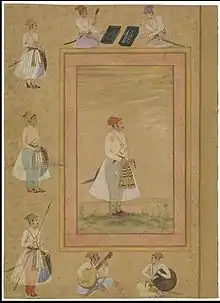Ram Singh I
Mirza Raja Ram Singh I was the elder son Mirza Raja Jai Singh I and was ruler of Amber (now part of the Jaipur Municipal Corporation), and head of the Kachwaha Rajput clan, from 1667 to 1688. He was subehdar of Kashmir from 1675-1680.
| Ram Singh I | |||||
|---|---|---|---|---|---|
| Mirza Raja of Hindustan | |||||
 | |||||
| Reign | 1667–1688 | ||||
| Coronation | 10 September 1667 | ||||
| Predecessor | Jai Singh I | ||||
| Successor | Bishan Singh | ||||
| Born | 1640 Amber, Rajputana | ||||
| Died | 30 April 1688 (aged 47–48) Kohat, Pakhtunkhwa, Mughal Empire | ||||
| Issue |
| ||||
| |||||
| Dynasty | Kacchwaha | ||||
| Father | Jai Singh I | ||||
| Religion | Hinduism | ||||
He was commissioned by the Mughal Emperor Aurangzeb in 1667[1] to invade the Ahom kingdom of present-day Assam,[2] but the loss at the ultimate Battle of Saraighat and the subsequent retreat[3] led to his recall and disgrace.[4]
Shivaji and Ram Singh
The Maratha ruler Shivaji, accompanied by his son Sambhaji and other officials and servants, was received by Kanvar Ram Singh at his military camp in the suburbs of Agra city (12 May 1666). Ram Singh escorted them to meet Aurangzeb at the Diwan-e-khas (hall of special audience) in Agra fort. Here they gave a customary present (nazara) of 1,500 gold pieces (mohurs) at which, Aurangzeb cried out, "Come up Shivaji Raja!"
Shivaji was taken to his place among the nobles who stood in two parallel columns in front of the throne. Shivaji didn't receive any gift or honor from the emperor nor had there been any serious negotiations for his position.
It happened to be the emperor's birthday and robes of honor were given to the high ranked nobles like the prime minister Jafer Khan and Jaswant Singh of Jodhpur (commander of 6000. But the highest ranking Mughal noble was Raja Jai Singh I, a commander of 7000). All this while Shivaji had been forgotten. Shivaji was deliberately made a commander of 5000 by Aurangzeb and was made to stand behind mansabdārs (military commanders) of his court. Moreover, the noble in front of him was Rai Singh, also a commander of 5000 but of a higher grade. The nobles in front of Shivaji were the ones whom Shivaji had comprehensively defeated in the past. Shivaji took offense at this seeming insult. His loud voice and angry gestures caused a minor commotion, Ram Singh came to him and tried to calm him down but the Maratha king couldn't be pacified. Shivaji stormed out of the court and was promptly placed under house arrest by Aurangzeb, under the watch of Fulād Khān, Kotwal of Agra.[5]
Notes
- "Learning of the loss of Kamrup on 19th December 1667, Aurangzeb decided to at once retrieve imperial prestige and regain lost dominion" (Sarkar 1992:211)
- "(Aurangzeb) commissioned Ram Singh of Amber, son of the distinguished general Mirza Rajah Jai Singh, and a commander of 4000, to lead an invasion of Assam." (Sarkar 1992:211)
- "Weakened by repeated defeats and consequent losses and losing all hopes of recovering imperial grace by defeating the Ahom monarch, Ram Singh left Kamrup in early April 1671 and returned to Rangamati." (Sarkar 1992:227)
- "Aurangzeb at once demoted the Rajput general by 2000 and ordered his recall. Accordingly, he made over charge to Abu Nisar Khan and had audience with the Emperor on 25 June 1676." (Sarkar 1992:228)
- Purandare, Babasaheb. Raja Shivachhatrapati.
References
- Sarkar Jadunath (1984, reprint 1994). A History of Jaipur, New Delhi: Orient Longman, ISBN 81-250-0333-9.
- Sarkar, J. N. (1992), "Chapter VIII Assam-Mughal Relations", in Barpujari, H. K. (ed.), The Comprehensive History of Assam, 2, Guwahati: Assam Publication Board, pp. 148–256